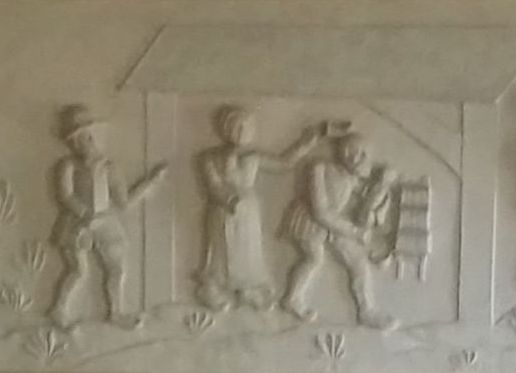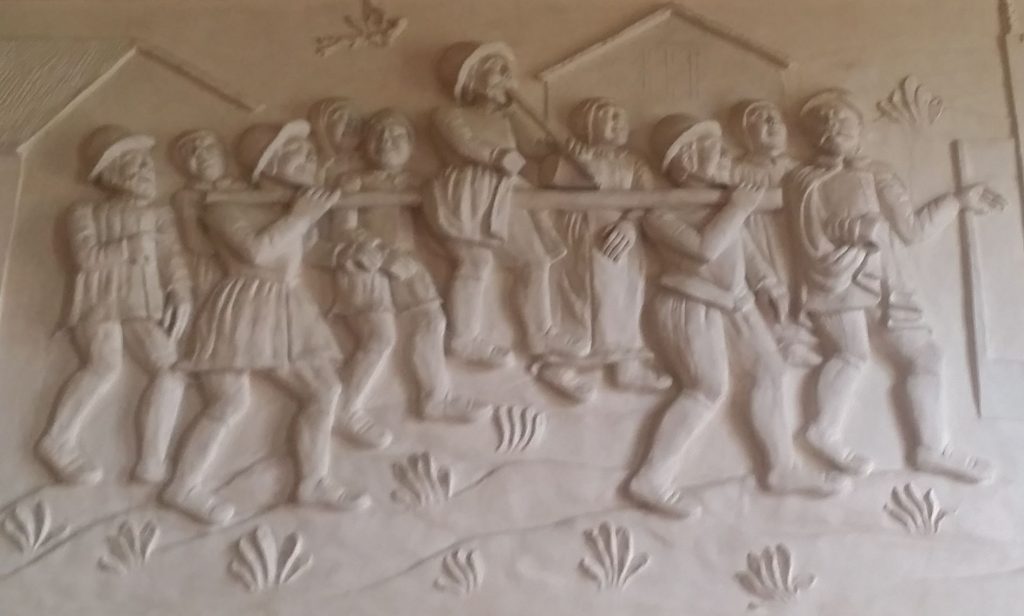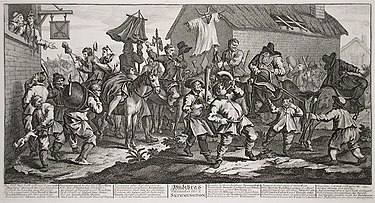
I wrote about the custom of Wife-Selling which appears as the main plot driver in Thomas Hardy’s 1886 masterpiece ‘the Mayor of Casterbridge’. Later in the book another folk custom brings the erstwhile Mayor to the brink of suicide. This was the Skimmity Ride, or Skimmington Ride.
The ride, which has deep roots in history, was designed to humiliate a member of the community and it consisted of a procession through the streets of the community with music or at least percussion instruments. Those being mocked, or an effigy of them or a local dressed up to look like them rode a horse or donkey or sat on a pole.
The illustration above is from the early 17th Century. It is in Montecute House, in Somerset above one end of the Great Hall of Sir Edward Phelips, who rose to the top of the legal profession becoming Master of the Rolls. And yet he choose to have a representation of popular justice in this prestigious part of his house. ( more information here)
The ‘offence’ is seen on the left – a neighbour sees the wife hit her husband over his head with a clog while he is trying to get a drink of beer at the same time as holding the swaddled baby. They live in a simple thatched cottage.

The normal interpretation is that she is ruling the roost and taking over the man’s role. It is he who is being punished for losing control to his wife and he is seen ‘riding the stang’, or pole either in person, or in effigy, or played by a stand-in. It would be nicer to think he is being punished for being drunk in charge of a child. The Skimmity Ride is heading from the couple’s home to the Church, and thus shown as involving the entire community.

In the fictional ‘Mayor of Casterbridge’ skimmity ride effigies of the ex-Mayor and his lover, Lucetta Le Sueur, are tied back to back on a donkey and paraded through Casterbridge. She has just married the Mayor’s rival and on seeing the skimmity ride has a seizure which kills her. Henchard, full of remorse, decides to kill himself in the local river, but as he looks down into Ten Hatches Hole he sees an image of himself which stops him jumping in. It turns out to be his Skimmity effigy but he, none-the-less, sees it as divine intervention.
William Hogarth also portrays a Skimmington Ride in his illustration for Samuel Butler’s ‘Hudibras’. It illustrates the cacophonous nature of the Skimmington with horns and percussion the main forms of ‘music’.

You might also like Cunning Men in Thomas Hardy’s fiction.
Discover more from And Did Those Feet
Subscribe to get the latest posts sent to your email.

Thank you! I had no idea what a skimmity-ride was when I first encountered it in The mayor of Casterbridge.
Thank you, its an interesting custom, could be either quite a way of keeping rich people in check or a way of being really nasty!
Or both
Thank you for your detailed article.
gyankundli.com